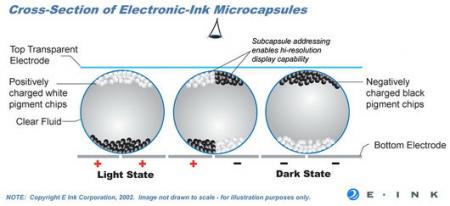I'm telling you stream crossers, I am a rather avid reader. Maybe not as much in recent years as I used to in University, but I still enjoy a good book.
I remember getting on the subway and having a solid 30-40 minutes of reading, both ways. I would pour through Dragonlance novels in two weeks, if not faster. Alas, once I started driving to work, my reading time evaporated (I work too far to take the bus).
Currently I am reading the Harry Potter series off of my Palm Tungsten E. The text is perfectly readable, and with the right piece of software, I can actually correct the book as I go along. However, the screen is rather small, and the battery life leaves something to be desired. I think I can get about 1-1/2 hours of reading on a full charge.
I decided to go about looking for new alternatives, and what I discovered was encouraging in features and disappointing in prices at the same time.
Almost all current ebooks use what is known as e-Ink, as their screen. It is a technology developed at MIT that uses small spheres packed with white and black pigments to display items on screen. The two pigments have a positive or a negative charge. Electrodes under each sphere generate a charge to push one pigment up and pull the other down, changing the colour of the sphere. (see photo below)
Reading-wise, this material really simulates paper. Since it is not backlit, you do need proper lighting to read it in the dark or poor lighting conditions (ie. a book light) just like a real book.
The advantage of this is that power is only consumed to change the display, allowing you to read at your leisure. Power consumption is measured by page turns, not hours.
Another thing I found is that most support PDF and plain text documents... and, of course, their own personal proprietary format for selling you books.
This didn't interest me very much, as there are enough books available out there on Project Gutenberg that I didn't need to buy books anyway. More on that site in my next posting.
Most ebooks also had memory card slots built in so you could load your favourite ebooks on your own without installing fancy software.
Three devices that repeatedly jumped out at me were the following:
There are others, but these are the big boys of the ebook world.
The best (and most expensive) is the iRex iLiad. It boasts the biggest screen (8.1 inch diagonal), Wi-Fi and wired lan, USB port, touch sensitivity (only works with the included stylus), and Compact Flash storage slot. It also has an MMC slot, but it won't work with SD cards. This device is almost a laptop, but not quite. Since it has a heart of Linux, it can run software specifically written for it. It supports the following formats PDF / HTML / TXT / JPG / BMP/ PNG / PRC (Mobipocket). It has a headphone jack, but its website doesn't specify what audio formats it supports. Book reading is just one of its uses since it has a touch screen, but at $700, if you are just looking for a book reading device, look elsewhere.
Then there is the Amazon Kindle. It is a smaller, more dedicated device with a 6 inch screen. This device has a keyboard built in. It also has a USB port and an SD card slot. It does not have Wi-Fi connectivity, but a built in cellular modem, which probably requires a subscription service. Since it is highly tied into Amazon's book sales business, its file support is pretty piss poor. It supports only text, HTML, unprotected Mobipocket. PDF is not fully supported. Other formats are only supported through conversion to the reader's native AZW format. It also supports MP3's and Audible's audio book format (.aa). At $400, I would have expected better file support.
Finally there is the SONY Reader. Normally, I loath SONY, but then they pull shit like this and make a device I just LOOOOOOOOVE! SONY's device has the same size screen as the Kindle, but without a keyboard, so the overall device is smaller. It supports Memory Stick Pro Duo (of course) and SD Cards (wow, surprise to me!). It has no Wi-Fi or lan connection. Books are transferred via USB to the device or memory card. You may be able to use a card reader to put books onto the card, I don't know yet. It supports PDF, TXT, RTF and its own BBeB format. DOC format only supported by conversion to RTF by the SONY software, but you have to have Microsoft Office installed first. It also supports JPEG, GIF (not animated), PNG, and BMP (all images displayed in greyscale). It maily supports Windows, but the latest model can be mounted as a drive in Mac OSX and Linux to transfer files. The Canadian website even has PDF instructions on how to produce optimally sized PDF's using various word processors. It also supports MP3 and unprotected AAC files for audio books or listening to music while you read. At $300 it is the least expensive of the three, but it is still pricey.
Personally, my recommendation is to stay with a regular book for now. $300 is crazy, and the others are off their rocker! I'm hoping that SONY will eventually knock the price to about $150, but I would probably be elected President of the World before that happens. Before the price goes down, they'll just add a new feature and keep the price at $300. So I'm predicting that at least for the time being, I won't be getting an ebook. I'm not some loony, early adopter. I'm not going to pay a premium just to have the price drop in six months *cough* iPhone *cough* Losers *cough* Ahem...
So this is Soundwave on board the Nemesis, signing off for now!
"bah weep graaagnah wheep ni ni bong"
Carousel
Tuesday, April 22, 2008
A Library in Your Pocket, the eBook
Uploaded to the World by
Soundwave
at
10:19 p.m.
![]()
Subscribe to:
Post Comments (Atom)

2 comments:
Can you see this think EVER getting off the ground, (aside from the obvious advantage for technical manuals)? The whole point of books is that they don't need anything to work. Ebooks have a place, and it will be harder to find that place than to get decent technology, which is already pretty good if you think about it.
Honestly, no. At $300+ ebooks will go the way of the PDA. Flash in the pan with the hard core tech crowd, then nothing.
For these things to really catch on, they need to drop down to less than $100, and preferably down to $50 each.
While not as convenient as a book, you gain the ability to carry multiple books in the same space.
With the eInk screen, these devices are remarkably low powered.
I think that they have the potential to become the MP3 players of the book world.
$300 will buy you 15 books at $20 each. The casual reader is better off just buying the damn books!
If you are an avid reader, and combine such a device with classics available on gutenberg.org, then this device will pay for itself quickly. If you need to read the latest and greatest, then you aren't saving any money, because you still have to buy those books in order to read them.
They really have to get the price down on those things if they really want the market to thrive.
Post a Comment